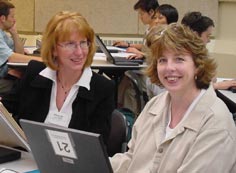|
Writing Objectives
The objectives we ask teachers to write in the CoBaLTT program are very
specific and detailed. It has been our experience as teacher educators that
the more specific teachers can be about the objectives they have for a lesson,
the better able they are to integrate language and content instruction in
the lesson in meaningful ways.
Categories of Objectives for CBI:
In content-based instruction, objectives should be divided into a number of categories. At least two categories—content and language—are necessary, but others can also be added; for example, "Learning Strategy/Skills Development" objectives may include mention of specific learning strategies or technology skills or social skills that students are expected to utilize in the lesson. "Cultural objectives" may also be included.
Content Objectives
Like content goals, content objectives refer to concepts related to the
academic content of the lesson or the topic of the lesson.
Students will:
- display an understanding of the cinematic elements that define
film genres.
- demonstrate an understanding of some of the reasons why some
indigenous peoples flee Central America and seek refuge in the United
States.
- identify the primary geographic regions of Spain.
Culture Objectives
Culture objectives identify learning about a particular
culture or may involve cross-cultural comparisons.
Students will:
- display an understanding of the unique genres of Japanese film.
- demonstrate an understanding of Spain’s geographic features
by comparing them to familiar geographic features in the U.S.
Learning
Strategy or Skills Development Objectives
These objectives identify
specific strategies or skills (Chamot et al., 1999; O’Malley & Chamot,
1990), e.g., reading strategies such as using context clues, or development
of technology skills. Social objectives involve student learning behaviors
or small group cooperation.
Students will:
- identify cognates and use context clues to find the meaning of unknown
words.
- show the ability to work independently
- work cooperatively in pairs to complete assigned tasks.
Language Objectives
Language objectives refer to linguistic concepts,
including vocabulary, communicative functions, and grammatical structures.
In CBI, language objectives should be divided into two categories—content-obligatory
language objectives and content-compatible
language objectives. According to Snow, Met and Genesee (1989),
content-obligatory language objectives reflect language that is essential
for understanding
and talking about the content. Content-compatible language objectives
emerge directly from the foreign language curriculum. “Content-compatible
language objectives can be taught within the context of a given content
but are not required for successful content mastery” (Snow et
al., 1989, p. 206, authors’ emphasis). These objectives answer
the question: What additional language (vocabulary, structures, etc.)
can be taught within the context of this unit that don’t emerge
directly from the content? To further understand the distinction
between these two types of language objectives, see the features
of content-obligatory and content-compatible language objectives (PDF).
Most language objectives are best written with a “formula” in
mind to link the grammatical structures that are necessary for carrying
out a specific communicative or academic function along with the
words or phrases necessary for doing so. The following formula was developed
by Tara Fortune to help immersion teachers write more specific language
objectives. Later, you will have an opportunity to check how well
you
understand the formula (see Formula for Writing) and to practice using
the formula to write objectives (see Write Objectives).
The "formula" for
Language Objectives:
Students will use X (grammatical structure) to Y (communicative function) with Z (words/word groups).
For example,
Students will use prepositional phrases to identify the relative location of places with phrases such as to the south of, to the west of, to the north of, beside, between, etc.
Or:
To identify the relative location of places, students will use prepositional phrases such as to the south of, to the west of, to the north of, beside, between, etc.
Or:
Students will use prepositional phrases such as to the south of, to the west of, to the north of, beside, between, etc. to identify the relative location of places.
Examples of content-obligatory language objectives
Students will:
- use the present tense (3rd person sing/plural) to identify the location of geographical regions with the verb estar and directions, al
norte (north), al sur (south), al este (east), al
oeste (west) and vocabulary such as el océano atlántico, el mar mediterráneo, el mar cantábrico, Portugal, España, Francia, país (Francia está al norte; Portugal está al oeste de España etc.)
- use hay (there is/are) to identify geographical features with terms like las
montañas, el río, el desierto, el bosque, la costa
- use prepositions with estar in the present tense to identify locations with phrases like La
Sierra Nevada está en el sur del país.
- demonstrate understanding of what/where questions, such as ¿Dónde
están
los pirineos?
Examples of content-compatible language objectives
Students will:
- use the present tense to make comparisons between Spain
and the U.S. with the verb ser (3rd person sing/plural) and
como, e.g., El oeste de España (Extremadura) es como
el estado de Nuevo México.
- use the present tense to express like/dislikes related to
geographic preferences with prefiero, me gusta/n and no
me gusta/n. E.g., No me gustan las montañas; prefiero
la costa.
Sources:
Chamot, A. U., Barnhardt, S., El-Dinary, P. B., & Robbins, J. (1999). The learning strategies handbook. White Plains, NY: Addison-Wesley Longman.
O’Malley, J. M., & Chamot, A. U. (1990). Learning strategies in second language acquisition. NY: Cambridge University Press.
National Standards in Foreign Language Education Project. (1999). Standards for foreign language learning in the 21st century. Yonkers, NY: National Standards in Foreign Language Education Project.
Snow, M. A., Met, M., & Genesee, F. (1989). A conceptual framework for the integration of language and content instruction. TESOL Quarterly, 23, 201-217.
|

